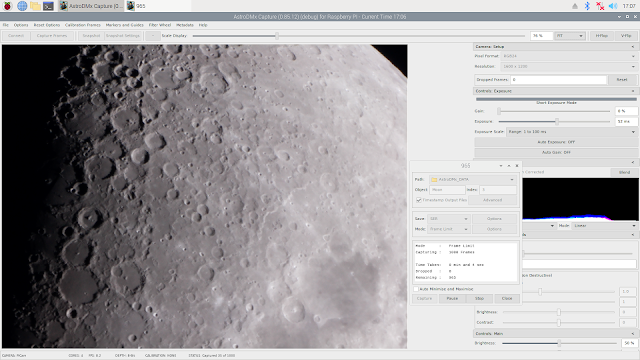Nicola has been working with the low level API for the HQ PiCamera.
AstroDMx Capture now has 8-bit support for the HQ camera with exposures of up to 1s. The documentation for the API is surprisingly incomplete, a consequence of which is that implementation takes much longer than for a USB astronomical camera. Such cameras have an SDK with a public interface that allows the camera to be implemented in capture software. Not so with the HQ PiCamera. This is not a USB camera, so the usual techniques won't work. Part of the job of the camera is carried out by the GPU part of the SOC, so the whole process of implementing the camera is different from a USB camera. The camera module constantly streams data to the GPU via a ribbon cable and the task is to capture the buffer and put it into the environment of AstroDMx Capture.
I have reported some bench tests on the camera, but can now report some lunar capture results on the 58% waxing Moon.
The HQ PiCamera was placed at the Cassegrain focus of a Skymax127 Maksutov that was mounted on a Celestron AVx GOTO mount. The HQ PiCamera was attached to a Raspberry Pi 4B with 4GB RAM and data were captured, using AstroDMx Capture, to an SSD that was attached to the Pi by USB3.0.
Click on an image to get a closer view
The equipment setup
Using AstroDMx Capture for the Raspberry Pi, 1000-frame SER files were captured of overlapping regions of the terminator.
Screenshots of AstroDMx Capture for the Raspberry Pi capturing Lunar data with the HQ PiCamera
The best 90% of the frames in the individual SER files were stacked in Autostakkert!, wavelet processed in Registax 6 and post processed in the Gimp 2.10
Individual overlapping panes comprising stacks of 900 frames each
The panes were stitched in Microsoft ICE to make a mosaic of the terminator
It is clear that the HQ PiCamera is a viable Lunar imaging camera with AstroDMx Capture for the Raspberry Pi. The camera is, for the moment, limited to 8-bits with a maximum exposure of 1000 ms. It is likely that Nicola will release this version as a work in progress some time in the near future. Further implementation will not have a high priority as work on this camera is very time-consuming, and other projects require attention.
AstroDMx Capture for Windows, macOS or Linux (Including Raspberry Pi) can be downloaded freely here:












